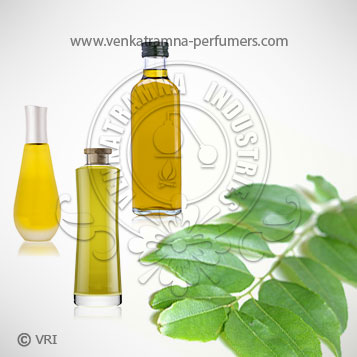
| Botanical Name | Murraya koenigi |
| Common Name | Curry Leaves |
| Country of Origin | India,sri lanka,malaysia |
| Solubility | Soluble in Alcohols, Essential Oils and insoluble in water |
| Specific Gravity | 0.87 |
| Optical Rotation | -27.24 |
| Refrective Index | 1.49 |
| PlantPart | Leaves |
| Bland With | ß-caryophyllene (2.6ppm), ß-gurjunene (1.9), ß-elemene (0.6), ß-phellandrene (0.5), ß-thujene (0.4), a-selinene (0.3), ß-bisabolene (0.3), furthermore limonene, ß-trans-ocimene and ß-cadinene (0.2ppm) |
| CAS No | 8006-78-8 |
| Flash Point | >100 °C |
| Extraction Method | Steam Distilled |
The curry tree is a small bush native to India that can be found growing almost everywhere in the Indian subcontinent excluding the higher levels of the Himalayas. In the East, its range extends into Burma. The leaves are distilled to extract the oil from the plant. Murraya koenigii is one of the plant species with potential medicinal properties. The whole plant and different parts of the plant are used to cure many human ailments. The oil is mainly used as stimulant, antidysenteric, anti-periodic, antiemetics, antidiarrheal, blood purifier, tonic, antifungal, depressant, anti-inflammatory. It can also be used to cure body aches, kidney pain, vomiting, stomachic, leucoderma, febrifuge, diabetes mellitus, besides promoting appetite and digestion. Carotenoids, carbazole alkaloids, coumarin, carbazole carboxylic acid, lipids and essential oil are the dominant phytoconstituents of the plant.
The use of curry leaves as a flavouring for vegetables is described in early Tamil literature dating back to the 1st to 4th centuries AD. Its use is also mentioned a few centuries later in Kannada literature. Curry leaves are still closely associated with South India where the word 'curry' originates from the Tamil 'kari' for spiced sauces. An alternative name for curry leaf throughout India is kari-pattha. Today curry leaves are cultivated in India, Sri Lanka, Southeast Asia, Australia, the Pacific Islands and in Africa as a food flavouring. Murraya koenigii is a native of India, Sri Lanka and other south Asian countries. Murraya koenigii is distributed throughout India and is abundantly found from Sikkim to Garhwal, Bengal, Assam, Western Ghats and Kerala. It reached to Malaysia, South Africa and Reunion Island from India along with South Indian immigrants. Murraya koenigii is more or less deciduous shrub or small tree reaching up to 6 m in height. The plant has a short trunk with 15-40 cm diameter, smooth, greyish or brown bark and has dense shady crown. The main stem is dark green to brownish in colour. The leaves are bipinnately compound, 15-30 cm long, each bearing 11-25 leaflets alternate on rachis, 2.5-3.5 cm long ovate lanceolate with an oblique base. The leaf margins are irregularly serrate and petiole is 2-3 mm long. Inflorescence is terminal cymes; each bearing 60-90 flowers. Each flower is bisexual, white, funnel shaped sweetly scented, stalked, complete, ebracteate and regular with average diameter of fully opened flower being 1.12 cm. The calyx is deeply lobed with five cleft and pubescent. Petals are five with free, whitish, glabrous dotted glands. Fruits occur in close clusters. They are small ovoid or subglobose, glandular, with thin pericarp enclosing one or two seeds which are spinach green in colour.
Color : Colorless to pale yellow clear liquid with sweet and spicy, with a bitter tone characteristic of some spices odor,
Aroma : It has a sweet and spicy scent.
Curry Leaf contains 0.5 – 0.8% essential oil with a decrease as the leaves mature. In the essential oil, alpha and beta pinene and caryophyllene exist and these are also common in allspice, clove and cinnamon.
Though there is no actual medical documentation available, aromatherapists have used Curry Leaf Essential Oil against diabetes, hair loss, and as a means of helping the skin maintain its natural pigmentation. Murraya koenigii (L.) Spreng or its common name curry leaf tree is a small strong smelling perennial shrub commonly found in forests as undergrowth. It was originally cultivated in India for its aromatic leaves and for ornament is normally used for natural flavoring in curries and sauces. The aromatic leaves, which retains their flavor and other qualities even after drying, are slightly bitter, acrid, cooling, weakly acidic in tastes and are considered as a tonic, anthelmintic, analgesic, digestive, appetizing and are widely used in Indian cookery for flavoring food stuffs COMMON USAGE • Cure diarrhea • Gastrointestinal protection • Antioxidant properties • Anti-diabetic properties • Fight cancer • Lower cholesterol levels • Good for hair growth • Radioprotective and chemo-protective • Protect against pathogen attack • Protect the liver • Skin care